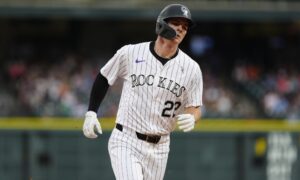Batted Ball Statistics are fairly straightforward: they express the share of a pitcher’s balls in play that are line drives, ground balls, or fly balls, including home runs that leave the ball field. This should get a sum of 100%. Pitchers have various varieties of pitchs and the way they approach each batter and that creates a different profiles of each of them to whether they are designated a fly ball pitchers, ground ball pitchers or somewhere in the middle.
Infield pop-ups are also tracked on FanGraphs (IFFB%), and they show the percentage of pitchers that induce fly balls in the infield. This is almost a no factor as this happens less frequently but do create an out.
- check out more from our sabermetrics library at Baseball Spotlight
Batted Ball Formulas
Line Drive Percentage (LD%) = Line Drives / Balls in Play
Fly Ball Percentage (FB%) = Fly Balls / Balls in Play
Ground Ball Percentage (GB%) = Ground Balls / Balls in Play
Infield Fly Ball Percentage (IFFB%) = Infield Fly Balls / Fly Balls
In general, batted ball line drives go for hits most often, ground balls go for hits more often than fly balls, and fly balls are more productive than ground balls when they do go for hits.
Less extra base hits are allowed by ground ball pitchers but they surrender a fair hare of singles usually throwing a two seam fastball or sinker. Less hit s are generally allowed by a fly ball pitchers but they may be more prone to give up home runs. They are mostly throwing the four seam fastball up in the strike zone,
This is taken from the thoughts on the sabermetric SIERA (now retired):
In general, ground balls go for hits more often than fly balls (although they don’t result in extra base hits as often). But the higher a pitcher’s ground ball rate, the easier it is for their defense to turn those ground balls into outs. In other words, a pitcher with a 55% ground ball rate will have a lower BABIP on grounders than a pitcher with a 45% ground ball rate. And if a pitcher walks a large number of batters and also has a high ground ball rate, their double-play rate will be higher as well.
As for fly balls, pitchers with a high fly ball rate will have a lower Home Run Per Fly Ball rate than other pitchers.
Check out more Sabermetrics from our Library at Baseball Spotlight.
——————————————————————————————
About the author– Tom Knuppel has been writing about baseball and sports for a few decades. As an avid St. Louis Cardinals fan he began with the blog CardinalsGM. Tom is a member of the United Cardinals Bloggers and the Baseball Bloggers Alliance. He also maintains the History of Cardinals website. More recently he has been busy at KnupSolutions and the primary writer of many sports at KnupSports and adds content at Sports 2.0. Tom is a retired High School English and Speech teacher and has completed over one hundred sportsbook reviews. He also can be followed on Twitter at tknup. Feel free to contact Tom at tknuppel@gmail.com
About the author– Tom Knuppel has been writing about baseball and sports for a few decades. As an avid St. Louis Cardinals fan he began with the blog CardinalsGM. Tom is a member of the United Cardinals Bloggers and the Baseball Bloggers Alliance. He also maintains the History of Cardinals website. More recently he has been busy at KnupSolutions and the primary writer of many sports at KnupSports and adds content at Sports 2.0. Tom is a retired High School English and Speech teacher and has completed over one hundred sportsbook reviews. He also can be followed on Twitter at tknup.
Feel free to contact Tom at tknuppel@gmail.com









